- Home
- Healthy living
- Hydrogenated Foods
Hydrogenated foods
Hydrogenated foods, industrially manufactured, made their debut nearly a century ago but the byproducts of that process have severely undermined human well-being; in particular the state of our blood vessels and the nervous system.
This explains the aversion of chiropractors and cardiac
surgeons to trans fats; they are nearly ten times more inflammatory than their saturated counterparts like LDL-cholesterol.
- Home
- Healthy living
- Hydrogenated Foods
Bio-hydrogenated fats, formed by bacteria in the gut of ruminants,
are completely different to those that are industrially manufactured;
many of the latter have never been encountered in nature.
Here's a bit of chemistry to start with; bear with me because it is not too difficult.
A century ago heart disease was almost unknown. Of course a few other things have also changed since then. Vitamin E, an anticoagulant found in whole wheat has been removed from flour to improve its shelf life; and cigarette smoking became a craze. A stressed lifestyle appears to have become the norm.
Refining wheat by removing the fatty fraction and the bran, vitamins and protein has turned the bread of most people's diets into a high glycemic index food; it releases an insulin surge in the body causing the glucose from the carbohydrate in white flour to be stored as fat.
A sedentary lifestyle and stress too have been stirred into the health goulash; chronic illness has become the norm in western society, with 60% of adult Americans suffering from at least one condition such as high blood-pressure, heart disease and diabetes, taking up 90% of the healthcare spend.
12% of adult Americans suffer from 5 or more chronic diseases.
Organic compounds
Organic compounds consist in the main of hydrogen and carbon atoms.
Thus we call them hydrocarbons; that's not difficult, so far.
In its saturated state, each carbon is linked to four other atoms by a single bond.
All the fats we eat are hydrocarbons, having a similar chemical structure; a long chain of carbons bonded to hydrogen atoms, with some oxygen thrown in.
They differ from each other in the length of that chain, the number of hydrogens linked to them (how saturated they are) and the shape of the structure.
They have, of course, a great many carbon atoms linked to even more hydrogens.
The molecule below, for example, is linolenic acid. It's found in many seeds and nuts, and is what we call an essential fat. You must have it in your diet, otherwise your brain and nerves will die; literally.
It consists of a string of carbon atoms which are displayed in black, and the hydrogens in white, with a couple of oxygens in red thrown in.
Hydrogenated foods
Hydrogenated foods have toxic byproducts that damage healthy nerves; trans fats are the very worst sort.
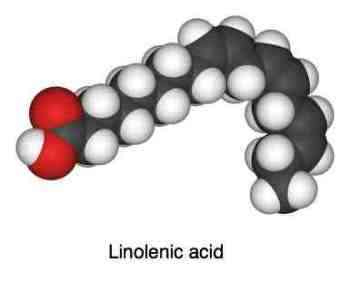
If you're interested, linolenic acid comes in two forms, one is the famed Omega-3, called ALA, the other an Omega-6. You can read more about them at this fish oil page...
- Flax seed nutrition information - freshly ground flax seeds provide the best vegetable source of omega-3.
"Organic chemistry is the science of carbon compounds. Biochemistry is the study of carbon compounds that crawl."
- Mike Adams
Saturated vs unsaturated
Having some understanding of saturated vs unsaturated is important.
This next molecule is methane. We're not yet at the stage of a hydrogenated food. Methane has one carbon atom. It's linked to FOUR hydrogen atoms - it is fully hydrogenated, and we say it is saturated with hydrogen. FOUR is the magic number with carbon.
It's really a three dimensional structure but most easily drawn like the CH4 on the left.
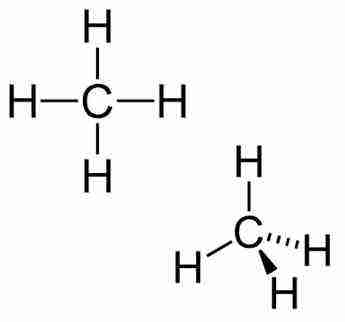
Hydro-carbons are a great source of energy, whether it's methane gas in an old-fashioned lamp, diesel in your fuel tank, or linolenic acid in your body. In the body they burn to form water (that is passed in the urine) and carbon dioxide that you breathe out.
Stick with me. This stuff is not so difficult, and if you wan't to know WHY hydrogenated foods in general and margarine in particular are so bad, then you need to grasp it. You can do it, promise! Bob's my uncle.
Now here's big brother Butane. He has four carbon atoms, each linked to FOUR other atoms. One of these links is with another carbon atom. Butane too is fully saturated, hydrogenated.
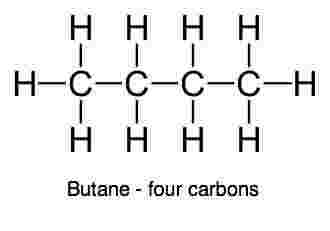
Like Methane, Butane is fully saturated - each carbon is linked to four other atoms. Count them. Got it? Magic number FOUR.
Jup, he's the guy dumb people use to light cigarettes. Between them butane and tobacco WILL knock ten years off your life. Interestingly research shows if you quit before 40-odd the effect will be minimal. If you can.
Trans fats
Now for Butane's first cousins - there are two of them, one named Peter, one named Paul - joking! Their surnames are Ethene, and their first names are Cis and Trans fats; and hydrogenated foods?
Cis butene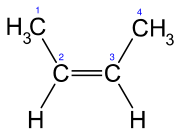
Trans butene
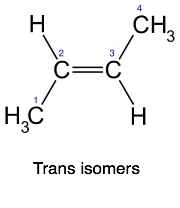
If you are observant you will have noticed two things about hydrogenated foods.
- Two of the carbons are linked to only THREE other molecules. Butene is not fully hydrogenated, it has less hydrogen; on a food label it would be described as 'partially hydrogenated oil'. It is UNsaturated. They have a "double-bond".
- Peter and Paul are both C4H8 but they have quite different structures. They are called ISOMERS; different structures of the same compound.
Most important for us is the fact that cis and trans have different properties, even though they are both the same compound. One may be a solid at room temperature, the other a liquid. More about this later ...
Saturated fats
Saturated fats, like cholesterol, have a high complement of hydrogen, just like methane and butane do. They are the ones that can clog your arteries and cause arteriosclerosis. They come in the main from animal sources. Beef, mutton, pork, eggs, dairy ... Whilst some cholesterol is essential in the body (for neurotransmitters) we really shouldn't eat too much of them.
Good fats
The polyunsaturated and monounsaturated fats are the healthy fats; some of them are 'essential'; we cannot live unless we are getting them in our diet. They perform vital functions like lining nerves (the myelin sheath), form cell membranes, aid in the absorption of minerals and vitamins, blood clotting and of course as a source of energy.
Linolenic acid is a polyunsaturated fat; it is essential and must be consumed daily.
Oleic acid is a monounsaturated fat; whilst not essential, the body can manufacture it, it is extremely beneficial to consume it daily too. It is found in olive oil; as a rule of thumb, when isolated from the foods like nuts, seeds, fruits like the olive and avocado, and vegetables they are liquids.
Coconut oil is the one where there is seemingly no agreement; it is high in saturated fat.
The problem with seed oils is that they are usually solvent extracted at high temperatures; look for cold pressed sunflower or macadamia oil for example.
What came as a surprise was that the people of the Mediterranean, despite a high olive oil fat diet, still had a low rate of heart disease; it seems that anti inflammatory oleocanthal gives the protection to the blood vessels.
The oleic in olive oil is an omega-9 fatty acid. It's not considered an 'essential' fatty acid as the body can manufacture it from other fatty acids, nevertheless is one of the healthiest of the fatty acids.
Our typical Western diet is too low in omega-3 and -9 and too high in -6 which despite being vital in small quantities is inflammatory if we have too much. Eat more fatty fish, walnuts and flaxseed for omega-3, and olives for omega-9.
The meat of animals that are grass fed are high in omega-3, as is fatty fish. So too are free range, cage free eggs. Avoid grain fed meat which is rich in omega-6 and highly inflammatory.
The move today from grass fed animals to grain explains why today we have so much cardiovascular and autoimmune diseases; the omega-6, despite being 'essential', if too much is eaten is highly inflammatory.
Bad fats
When a healthy liquid vegetable fat, often sunflower oil, is heated in the presence of hydrogen and a catalyst, atoms of the element are added to the compound; it becomes more saturated, but the result is equal quantities of the cis and trans forms.
Bad Boy Trans is very toxic to the human body.
Food manufacturers like it though because it is now a solid, and easier to spread and work with. Read the labels of the margarine, or the cookies and pastries, pizzas and dressings you buy; if they contain the term "partially hydrogenated fats" avoid them like the plague; you are dicing with death. Read more for example, at bettercreme sucks.
Foods with trans-fats cause inflammation in the body and particularly in the blood vessels; thus they are linked to high blood pressure, stroke and heart disease; and diabetes too. They increase the bad LDLs and reduce the good HDLs.
Even one of our favourites, Marmite, now has added trans-fats.
Researchers at Harvard have shown that if just 2% of the calories in your diet are from trans-fats, easily achieved if you are using margarine, the risk of cardiovascular illness rises by a dramatic 23%.
Type "bettercreme sucks" into Site Search to garner more information.
Exercise and cholesterol
Exercise and cholesterol are closely linked; but hydrogenated foods undermine the whole process.
Not only what you eat, but exercise too has an important effect on your blood-cholesterol levels. Read more about
Mutton stew
Are you concerned that your Saturated Fat is dangerously low? I'm kidding of course! Try our delicious mutton stew. Seriously, it's so full of fibre that it will probably lower the LDL in your blood stream. It has absolutely zero hydrogenated foods or oils; scrumptious and nutritious. It contains chickpeas, the second most important food in the fight against high cholesterol. Do you know what number one is?
- Chickpea garbanzo bean dip ... hummus is so easy to make.
- Foods that lower cholesterol ...
There is nothing new about all this, it's common knowledge, and I am sure you know it too. Now for the interesting bit; trans fats stimulate CETP.
Type "foods that lower cholesterol" into Site Search to garner more information.
Cholesteryl ester transfer protein (CETP)
Biochemistry is a complex subject, and a controversial one too. CETP is a protein in the body that breaks down the healthy anti-inflammatory HDL in your blood and transports it to the liver for degradation.
But CETP also mops up UNhealthy LDLs and converts them to HLD. Is CETP good or bad? No one seems to be quite sure.
What is known is that trans fats INCREASE the activity of CETP, which is potentially devastating if the breakdown of HDLs by CETP proves the dominant effect.
Transforming Growth Factor
The rule of thumb is avoid all hydrogenated foods, but if you want to know why, then some biochemistry may interest you. Transforming growth factor protects the inner lining of arteries against the toxic effect of chemicals for example found in cigarette smoke and high cholesterol; read, helps prevent high blood pressure.
But trans fats have been strongly linked to atherosclerosis or hardening of the arteries; research published in J Nutr Biochem has found that this happens because they suppress the action of TGF, "greatly" increasing the deposition of cholesterol in vascular tissue, to use the language of the researchers.
In short, if you have a diet high in hydrogenated fats and cholesterol, you will almost certainly end up on blood pressure medication, with all the side effects of chronic meds.
Increase your HDL healthy cholesterol
Anyway, overwhelming biochemical evidence is that you can increase your HDL by changing to olive oil benefits, eating more avocado (healthy fat), more fatty fish and increasing the fibre in your diet from fruit and salad. Oh, and nuts and seeds too, of course. All delic foods, so no problem there, right?
- Avocado fat ...
- Broccoli and salmon soup @ ways to cook salmon
- Pecans nutrition but only if they're freshly shelled, or vacuum packed.
UN-saturated fats.
These are the fats that have double bonds, and less hydrogen. They are UNsaturated.
They come in two forms, both of which are healthy.
- Poly-unsaturated (mostly in seed oils), and
- Mono-unsaturated (mostly in fruit oils like the olive and the avocado).
Why is this so important? In nature, we find only the cis-isomer in these double bonded fats. Cousin Healthy Cis. Cousin Trans is the black sheep of the family - he has no place in nature, and neither should we provide him with a place in our bodies. He's a very bad boy!
So why does the food industry take a very healthy oil like Sunflower Oil (which has only cousin Healthy Cis), and make it into a Hydrogenated Food, turning half of it into Bad Boy Trans? Margarine.
Properties of cis and trans isomers
It has all to do with melting points. Saturated fats have a higher melting point than unsaturated fats, so they are solids at room temperature; we prefer spreading solid saturated fat on our bread rather than liquid unsaturated oil.
Bad Boy Trans has a higher melting point than his cousin Healthy Cis. By hydrogenating liquid sunflower oil, the Hydrogenated Foods industry can make it into solid margarine at room temperature. Why? Because the public likes it that way. We want it, so of course they provide it.
However there is more to it than that. It may interest you, perhaps not. "Polarity" is what it makes for these differences. Cousin Healthy Cis is is more polar than Bad Boy Trans. This means the forces between the molecules are stronger, they pack more closely, and so they are more stable.
All good reasons why the Good Lord only provided us with cousin Healthy Cis to construct our nerves. Good stable nerves. Making nerves with a myelin sheath made of a mixture of Stable Cis and Unstable Trans is just asking for trouble.
Have you heard of motor neuron disease? It has to do with hydrogenated foods we think, but also about a low fat coupled with high carboydrate diet. You can read more about it at our tingling in arms and hands link lower down.
Most trans fats consumed are these days made industrially by the hydrogenation of oils like that from the sunflower, which has only the cis isomer in its natural form.
The goal of hydrogenation is to add hydrogen atoms making them more saturated and thus raising the temperature at which they from a solid to a liquid; read, turn them to solids. However, a side reaction also occurs changing some of the natural cis isomer to the very unhealthy trans form.
Hydrogenated foods are very toxic.
Unlike the other fats that we consume, the trans isomers are not essential for humans, neither are they healthy; eating trans fats increases the risk of cardiovascular sickens by raising levels of the bad LDL cholesterol and lowering the levels of the healthy HDL form.
Nutritional scientists recommend that consumption of trans fat be strictly limited; ideally we should have none at all. Naturally occurring fats contain only the cis isomer.
Chemically, trans and cis fats consist of the same amounts of hydrogen, carbon and oxygen, but they are arranged in a different way. This changes the normally kinked chain of carbons into a straight chain. results in a straight, rather than kinked, shape for the carbon chain.
This make this more like the straight chained saturated oils.
"Health authorities worldwide recommend that consumption of trans fat be reduced to trace amounts. Trans fats from partially hydrogenated oils are more deleterious than naturally occurring oils."
END OF STORY: LESS HYDROGENATED FOODS. Preferably none!
Unfortunately, food companies will by sleight of hand try to hoodwink you. For example, by the use of damn lies statistics the manufacturers of Marmite state there is no added fat; so how can 20% of the fat be trans?
Tingling in arms and legs
Tingling in arms and legs is a common complaint at the chiropractic coalface, and also in the disturbing letters that I receive from readers on a daily basis. Sometimes it's a pinched nerve, or too little blood, and diet certainly has a part; are you regularly eating hydrogenated foods?
- More from Wikipedia should you be interested. Cis Trans isomerism...
- Tingling in arms and hands
In conclusion,
- Look carefully at food labels and avoid hydrogenated and partially hydrogenated foods.
- Avoid margarine*.
-
On your bread? Here you sit rather between the
Devil and the Deep Blue Sea. Margarine or butter? Hydrogenated foods or a
cholesterol food? It's strictly my opinion, but I recommend small
amounts of butter over margarine, but this is definitely dependent on
your overall diet. If you're eating plenty of fruit and salads,
vegetables, enjoy ONE glass of red wine in the evening, you exercise and
your cholesterol is within acceptable norms, for my money, I would
choose butter every time. In moderation. Others have a different
opinion. Researchers are divided.
Better still, do what the Greeks and the Italians do. Dip your bread in olive oil, an UNsaturated fat. Less of that bad hydrogen that lifts us off to the place in the sky before our time!

Only, NOBODY IS SMILING!
Sandwiches at work, for my money, a small amount of butter. For your cheese and lettuce sandwich at home rather use olive oil than either butter or margarine.
I ALWAYS smother at least one of my sandwiches with Moutabel Baba Ghannouj (an eggplant spread, proved to lower cholesterol), hummus (a Chickpea Garbanzo bean dip) or Smoked Salmon Dip recipe. All can be made in ten minutes, but you do have to soak the chickpeas overnight and boil for an hour.
MARGARINE*
Okay, let's be honest. When various authorities make directly contradictory recommendations, it means the jury isn't out on the subject. Such is the recommendation to replace butter with margarine.
What are the known facts:
- Butter is saturated animal fat and high in cholesterol; not good obviously.
- Butter is better for cooking because saturated and mono fats
like olive oil are more stable to high heat than the polyunsaturates like
margarine and sunflower oil. Butter is healthier for frying and baking.
- Margarine is high in trans isomers, known to be bad for human health.
- A
recent meta analysis of 70 large research studies concludes that there
is no scientific evidence to suggest that margarine is more healthy than
butter.
- Butter is back in the jargon.
All of this has been complicated by a resurgence of the Bunting diet by professor Tim Noakes. Like all fads it is an extremism, with weight loss via the use of a high animal fat diet. Yet it has merit, and is effective, being a low carbohydrate diet.
More important, by adding fat, it lowers the glycemic index of any carbs in your food. Tomorrow there will be a new fad; weight-loss fashions are just as ugly as those of dress, demanding that they are replaced every season.
A plant phytosterol called beta-sitosterol is known to lower the harmful cholesterol LDL without lowering HDL, the friendly cholesterol. It's also very beneficial for the prostate gland. As a result, certain companies have started adding it to their margarines.
Hence the general recommendation of the last thirty-years has been that we should change from butter which is high in cholesterol to margarine which is low; but it conveniently ignores the toxic nature of hydrogenated foods.
Drugs.com makes this statement concerning the use of added beta-sitosterol to margarine in the treatment of prostatitis and high cholesterol:
It's important to note that hydrogenation into trans fatty acids occurs with margarine ingestion. Thus, margarine should be used in moderation, and only to lower cholesterol and in the treatment of prostatitis; it should not be considered the only therapeutic regimen in prostate and cardiovascular diseases.
Drugs.com
- Avocado benefits include being naturally rich in beta-sitosterol.
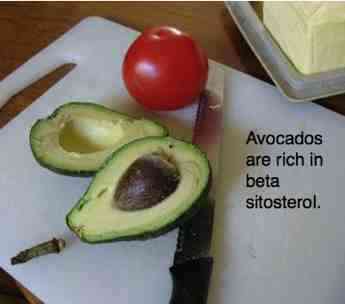
Tomatoes and avocados, together with pumpkins seeds and pollen in lightly filtered raw honey, make up prostate food, for the prevention of serious disease.
And, yes, butter is back.
WHY ALL THIS BIOCHEMISTRY ON A CHIROPRACTIC HELP WEBSITE
Firstly, I'm aghast at the number of my patients that drop dead from a heart attack. One last week, his funeral tomorrow.
But secondly HDL and the omega-3 in fish oil and flaxseed have strongly anti-inflammatory properties, not only good for your arteries, but good for the hyaline cartilage in your joints too. Fundamental in the prevention of inflammation be it in the arteries or arthritis in joints.
Secondly, it has important consequences for back pain sufferers. Research shows that those suffering from clogged arteries to the spine have more back pain.
IMPORTANT CONSIDERATIONS
- OLIVE BREAD RECIPE
- Tofu, a zero cholesterol protein. Read more about TOFU NUTRITION ...
- From HYDROGENATED FOODS to our FREE WEIGHT LOSS PROGRAMS ...
- Read more about the effect of red wine on cholesterol: CHOLESTEROL ALCOHOL ...
- Causes of osteoporosis ...
- What is CHIROPRACTIC?
- Home
- Healthy living
- Hydrogenated Foods
Did you find this page useful? Then perhaps forward it to a suffering friend. Better still, Tweet or Face Book it.
